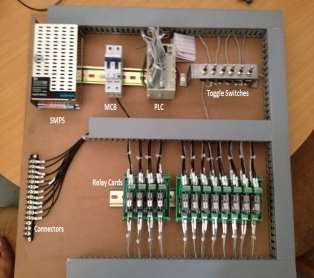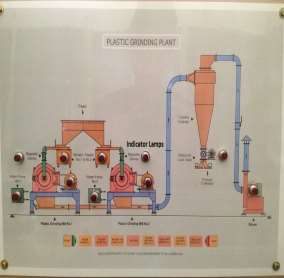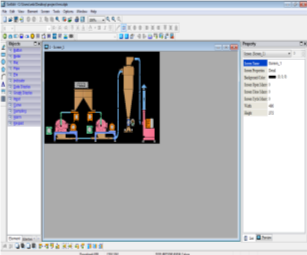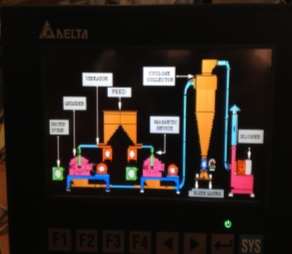Automation of Plastic Grinding Plant using HMI and PLC
CAREER EPISODE: 03
INTRODUCTION:
3.1) The career episode three presents an extensive description of the project “Automation of plastic grinding plant using HMI and PLC”. This project was part of my industry internship – “Project 2” in the final semester, as well as a requirement to complete my degree, Bachelor of Engineering (Electronics and Communication)from Gujarat Technological University, India. I started this project with a team of three engineers including myself and a project trainer. The project duration was five months which included project training, implementation and testing. We worked as Electronic engineer interns in “Mega Switchgears, India” for this project.
BACKGROUND:
3.2) In most of the small-scale industries the fault detection is done through manual means i.e. a lot of time is spent in identifying the exact point of error/failure in a particular system. It is a very exhausting task for the operator to check each and every machine in order to locate the error. To make work easier for the workers, we made an arrangement that displays a message on the HMI (Human Machine Interface) display which indicates the location of the error.
3.3) In this project, our main objective was to develop an automation system for a plastic grinding plant using HMI and PLC (Programmable Logic Controller). With the help of this automation system, we were able to monitor and control the plant from a remote location. In other words, status of each module could be monitored without going to the location of the plant and also it sends a message or alert with the location of the error whenever there is a problem or failure in the plant.
3.4) My roles and responsibilities included:
- Programming of PLC using WPL software
- Simulation of Plastic Grinding plant on HMI using Screen Editor software
- Assisting in designing the hardware prototype of plastic grinding plant
- Maintaining neat and organized electrical connection between different components
- Discuss future tasks and assess every team member’s work in weekly meetings.
- Maintain technical documentation.
3.5) Project mechanism











PERSONAL ENGINEERING ACTIVITY
3.6) For this project, we went through an extensive training program for five months and simultaneously we completed our project implementation as well as the testing. We were working as interns in the organization. This training gave us an insight to the technical culture of an electronic industry. During this internship, we came across many new electric components such as PLC and HMI and learnt new approaches to design an electronic circuit in an organized manner as per IEEE design standards. I was trained by the project trainer in programming the PLC and HMI using different softwares. As a team, we were trained in designing and implementing the prototype of an automated plastic grinding system. During our training, we were also given lessons on safety measures to avoid hazardous situations. For a safety environment, we were provided gloves, clothes and glasses to design electronic circuit and mechanical hand.
3.7) Hardware Implementation
We started with the designing of the prototype, discussed regarding the work process of the system and selection of components. In this project, we used DVP12SA PLC which was selected under the guidance of our project trainer and depending upon the application of the project. It consists of 8 input ports and 4 output ports. PLC is programmable controller which comprises of a microprocessor, input and output module, memory and power supply. It behaves according to the status of the input and output ports which depends upon the stored program in the memory of the PLC. Therefore, we decided to use PLC for our project. For the controlling and status condition of each module of the plant, I have used 8 channel and 4 channel relay cards, toggle switches and indicator lamps. Relay card is a device on which relay is mounted and can be used for controlling purpose, toggle switches for controlling certain aspects of the machines and indicator lamps are used for indication purpose of plant condition. These lamps have very good visibility.RS232 cable is used as a programming cable and RS485 is used to interconnect the PLC and HMI. To provide efficient power, in this project we have incorporated SMPS (Switched Mode Power Supply)


Hardware Implementation with the mimic of the plant
3.8) Furthermore to automate the plastic grinding plant, we have also used Delta (DOPB07S211) HMI. I decided to use HMI in our project because it allows you to design the perfect plant diagram using a software and shows on the display screen. This made it really easy for me for the simulation process as well as monitoring the point plant from a remote location. The key feature of HDMI is to detect the exact location of the fault in the plant whenever any abnormal condition occurs such as If any motor will trip due to any abnormal condition then motor and related device process will stop and hooter gets ON, that gives a warning to the operator with audible sound. Operator can also verify which motor is tripped by visual indication on mimic by indicator lamps.
3.9) Software Implementation
For software implementation, I was trained by our project trainer for two months. I used WPL Editor for PLC programming. This software is capable of providing 3 languages i.e. Ladder (LAD), Instruction (IL) and Sequential Function Chart (SFC). It was easy to use the software but it was as difficult to program the PLC because the programming was implemented depending upon the various conditions of the plant and in those situations what action should be taken. After every minor implementation, I used to verify the action of the PLC in order to complete the programming successfully. For this project, I used Ladder language to program the PLC.
3.10) The second software which I was trained for was Screen Editor. I used screen editor to design the mimic diagram of plastic grinding plant with touch buttons that were used to control each module of the plant. This software is comparatively much lucid than WPL Editor software. I also incorporated colour code system for various fault condition such as follows:
- REDFeedback/Input is not given in system
- GreenSystem is running smoothly with no fault conditions
- YellowInterlocking the problem in the system


Screen EditorHMI Display
SUMMARY:
3.11) In the end after the implementation and documentation, we presented our project with the automated prototype of plastic grinding plant and gave a presentation in front of our faculty. The overall journey of this project was very productive in terms of learning, acquiring knowledge and enhancing technical skills. I faced many tough situations while pursuing this project such as programming the PLC and constructing the prototype but working under the guidance of our project trainer and as a team, made the project look easily achievable. For future prospective, system can be controlled using a computer at remote location by connecting HMI with an ethernet cable, record of faults occurring in the system can be recorded in the excel sheet and the system can be also password protected.